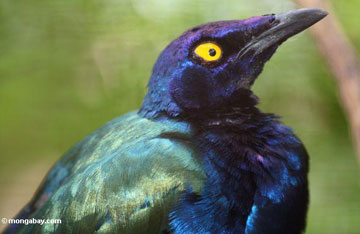Global warming will hurt migratory birds
Global warming will hurt migratory birds
mongabay.com
May 7, 2007
84 percent of migratory birds have the potential to be affected by climate change warned the United Nations Monday. Lowered water tables, changes in food supplies and prey range, rising sea levels, and increased storm frequency are the greatest threats to birds, said officials with the African Eurasian Migratory Waterbirds Agreement (AEWA) and the Convention on Migratory Species (CMS), two United Nations Environment Programme (UNEP)-led Treaties for the conservation of wildlife.
“Migratory birds are particularly vulnerable because of their use of several habitats during migration as stopover sites for feeding, resting or to sit out bad weather.” said Mr. Bert Lenten, Executive Secretary of the AEWA Agreement and initiator of the World Migratory Bird Day campaign, an international public awareness event focusing every year on a different threat or obstacle to migratory bird species.
 Purple Glossy Starling (Lamprotornis purpureus) The U.N. says that rising sea level will reduce habitat availability of species that nest or forage in low-lying coastal areas, while the forecast increase in drought will likely widen African deserts which will present significant barriers to migratory birds. The U.N. warns “this will especially affect the ability of Afro-European migrants to fatten sufficiently prior to crossing the desert.” |
The U.N. said that critical avian habitats are at risk due to increasing desertification, flooding, rising temperatures, and shifting ecological communities. Habitat change is expected to be greatest in the Arctic and other high latitude regions where many species migrate, but habitat loss will also affect stopover spots, compromising migrants’ ability to complete their migrations.
Lenten added there are already signs that climate change is causing birds to migrate earlier, change their routes or in even abandon migration all together.
“Examples include Cranes which normally migrate to Spain and Portugal but now stay in Germany. However as they are not used to low temperatures, there is a danger that most of them would not survive a hard winter in Germany” said Lenten.
“The results of several studies investigated show that as the temperatures becomes warmer, migrant species in temperate latitudes, such as the Pied Flycatcher (Ficedula hypoleuca) arrive on their breeding grounds earlier than expected,” stated CMS in a release. “The timing of arrival on breeding grounds is important especially as it has to be synchronized with availability of prey.”
“Climate change will impact on the species of prey just as they impact on the birds themselves severely impacting on the populations of many species. Early spring might lead to a shift in the prey (insect hatching) or a shift in vegetation bloom. Unfortunately these shifts are not in line and may occur before the young birds hatch. As a result the birds may not provide enough food for their offspring,” the statement continued.
Helping migratory birds adapt to climate change
The U.N. said it is not too late to help birds cope with climate change. Protecting key stopover and nesting habitats make a critical difference in the survival of some migratory species.
“In order to combat the extra threat of climate change, we need to protect or create more habitats for migratory birds and other animals, including ponds and other wetland sites to help waders and other waterbirds complete their exhausting journeys in even more difficult climatic conditions,” said Robert Hepworth, Executive Secretary of CMS.